Although Canada is not the most biodiverse country in the world, it is the second-largest country by landmass. Because of Canada’s wide open spaces and low human population, the wildlife that does live here thrives. Canada is home to some beautiful freshwater lakes, with over 550 large natural lakes. Lake Superior is the largest freshwater lake found here and is 31,700 square miles in area. As you can imagine, there are a variety of fish that live in Canadian waters – both freshwater and saltwater. In fact, there are over 1,000 fish species total that call Canada home. Here are 6 of the biggest fish that can be found in Canadian waters.

9. Northern Pike (Esox lucius) – up to 4 feet long
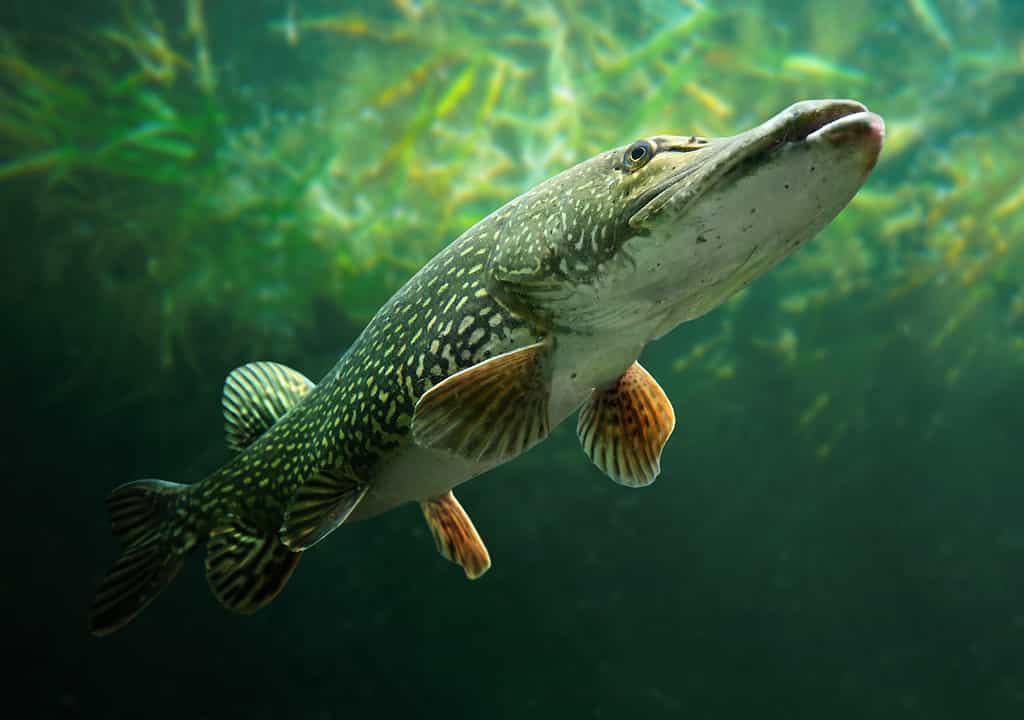
These fish are some of the most prized sport fishing catches in Canada!
©iStock.com/abadonian
The northern pike is one of the largest freshwater fish in Canada that can grow up to 4 feet long and weigh over 40 pounds. These fish have elongated bodies that are a shade of green. Northern pike have large mouths that are filled with sharp teeth – perfect hunting weapons. As their name suggests, these fish can be found in northern regions of the world, including Canada. Additionally, they prefer to live near underwater structures such as fallen trees and vegetation, which they use to their advantage to ambush their prey.
The northern pike is an aggressive ambush hunter. The diet of the northern pike mainly consists of small fish, crayfish, and even small mammals. They also occasionally feed on frogs and even birds. Their technique for catching their next meal is speed, reaching speeds of up to 10 miles per hour in an explosive burst. Because of their size, they are also prized for fishing. Anglers flock to Canadian lakes to try their hand at catching some of these massive predatory freshwater fish. Northern pike are also known for putting up a fight when caught on a fishing line, making them an exciting fish to catch!
8. Chinook Salmon (Oncorhynchus tshawytscha) – up to 5 feet long

Chinook (or King) Salmon are the cream of the crop when it comes to salmon used in cooking.
©Crystal Kirk/Shutterstock.com
Often referred to as the “King of Salmon”, chinook salmon are the largest species of Pacific salmon. They can grow on average to be between 30 and 47 inches long, with the record being set at just under 5 feet! These prized fish have also been recorded to weigh up to 126 pounds, though their average weight is around 30 to 50 pounds. They have a blueish-green coloring which transitions to a silver underbelly and small black spots on the back. These salmon are also known as “blackmouth salmon” due to their black tongue and gums.
Chinook salmon are born in freshwater rivers and migrate to the ocean to grow. Once mature, they will return to freshwaters to spawn. These fish feed on various insects and small aquatic life in rivers. When they travel to the ocean, they primarily eat squid, shrimp, and other small fish. Their aggressive feeding habits allow them to multiply rapidly. Chinook salmon are a delicious and highly sought-after fish species.
7. Muskellunge (Esox masquinongy) – up to 5.6 feet long
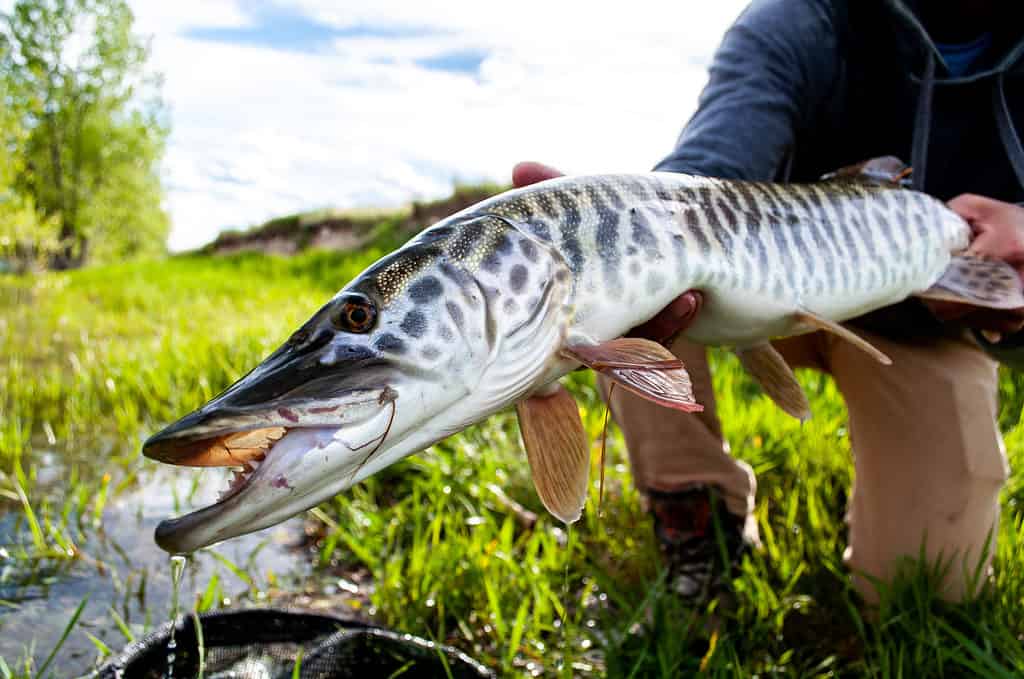
As one of the largest freshwater predatory fish in Canada, the Muskie is a highly sought-after fish by anglers.
©Jennifer de Graaf/Shutterstock.com
The muskellunge, commonly known as the muskie, is a large predatory fish found in freshwater lakes and rivers. These fish have streamlined bodies and large mouths full of sharp teeth. They are large and can grow up to 5.6 feet long and weigh around 60 pounds. They have a mottled green or brown body with vertical dark stripes or spots along their sides and a long dorsal fin that is placed far down on their backs. The appearance of the muskie makes it clear that it was built to be a predator – this fish has speed, power, and stealth.
The muskellunge like to live in large, clear lakes with a depth of at least 20 feet. The diet of the muskie includes large prey, even consuming waterfowl such as duckings and small fish such as yellow perch, whitefish, and crayfish. Muskies are apex predators in their ecosystem, as no other creatures prey on them. This fish is also commonly known as the fish of 10,000 casts, as they are extremely difficult to catch. Surprisingly, they can even recognize artificial lures and avoid them. So, if you manage to reel in a muskie, give yourself a pat on the back!
6. Lake Sturgeon (Acipenser fulvescens) – over 7 feet long
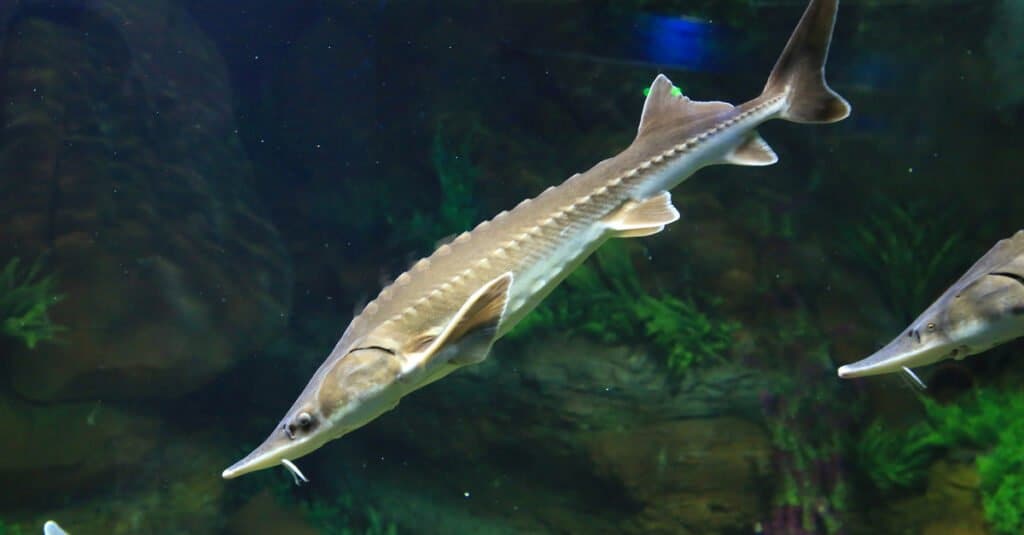
These massive bottom feeders have a prehistoric look and can grow to incredible lengths.
©Geermy/Shutterstock.com
The lake sturgeon is one of the biggest freshwater fish in Canada that can grow to over 7 feet in length. This fish is also commonly known as the rock sturgeon due to its prehistoric looks. Lake sturgeons are bottom feeders that inhabit the bottoms of large lakes and rivers. These massive fish can weigh over 300 pounds! The dorsal aspect of the fish is gray or dark olive. The ventral aspect of the fish is white or yellow. The body of this creature is long, and the snout has barbels at its tip. These fish have scales and scutes. The mouth of the lake sturgeon is made to suck up food which scientists argue makes them omnivores rather than carnivores.
The diet of the lake sturgeon is varied – as with most bottom-dwelling fish, it will essentially eat anything that it comes into contact with that it can suck into its mouth. This can include insect larvae, snails, small fish, and crayfish. The adult lake sturgeon is too large to be preyed on by other fish, except for the lamprey. The lamprey preys on the lake sturgeon by attaching itself, cutting a hole, and feeding on the bodily fluids.
5. White sturgeon (Acipenser transmontanus) – around 10 feet long

The largest freshwater fish in North America (by quite some margin), white sturgeon can grow to over 11 feet long!
©CSNafzger/Shutterstock.com
The white sturgeon is the largest freshwater fish in Canadian waters and in all of North America. All sturgeon are anadromous, meaning they spend part of their lives in the sea and part of their lives in freshwater. These amazing fish are huge. The largest recorded was 11.7 feet in length and weighed 1,100 pounds. However, there have been unconfirmed reports of white sturgeon reaching up to 20 feet in length. Despite the fish’s name, the white sturgeon is not predominantly white. Instead, their dorsal area is grey or brown, while their ventral area is white. These fish do not have scales and rather have rows of scutes which are bony plates. They have distinguishing barbels around their mouths, which help them sense their prey.
The white sturgeon inhabits both freshwater and saltwater bodies. They can be found in Canada, the United States, and Mexico. The fish swim through estuaries to move upriver to spawn. White sturgeons are carnivores and eat other fish, small crustaceans, and aquatic insects. Being as massive as they are, white sturgeons rarely fall prey to other animals. That said, as juveniles, these fish can face predation from larger fish such as salmon and species of sharks.
4. Blue Shark (Prionace glauca) – up to 13 feet long
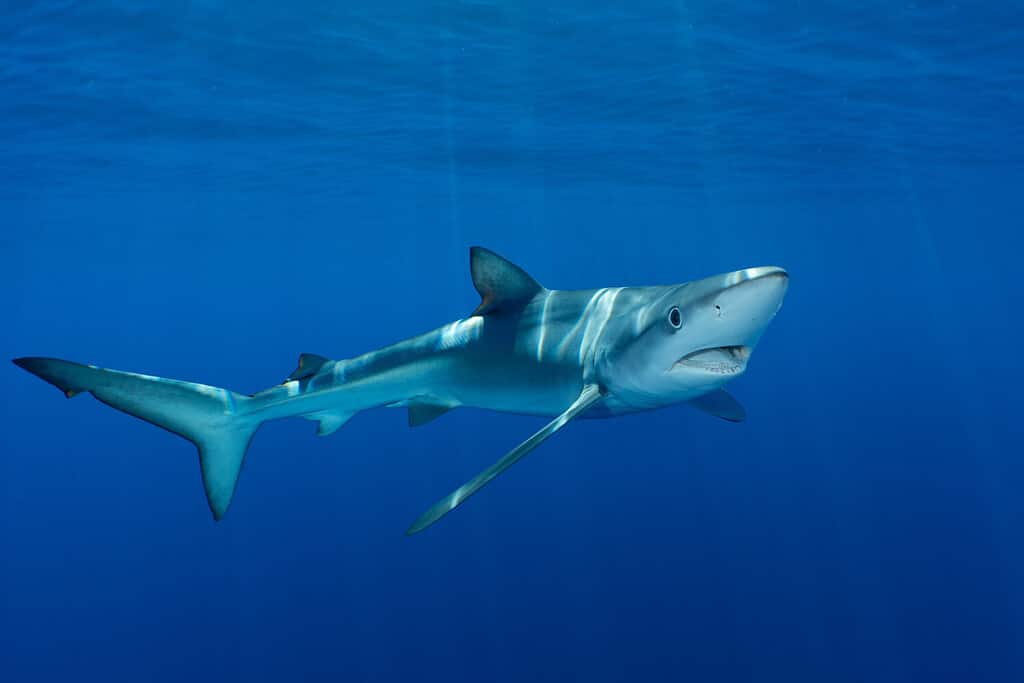
A relatively small to medium shark, blue sharks can be found along the Canadian coasts.
©Samy Kassem/Shutterstock.com
The blue shark gets its name from the bright blue coloration on the upper half of its body. It has a long slender body and a pointed snout. These sharks can reach lengths up to 13 feet long but are more commonly around 10 feet in length. Although large, they are only medium-sized compared to other sharks, weighing around 300 to 450 pounds.
Blue sharks inhabit oceans around the world, including Canadian waters. They are a migratory species and will travel great distances in search of food. They eat a variety of sea life, such as small fish, squid, octopus, and even other sharks. These sharks are notoriously curious and will often get close to fishing boats or fishing gear. Luckily they are not usually aggressive toward humans.
3. Atlantic Bluefin Tuna (Thunnus thynnus) – up to 13 feet long

Growing to unbelievable sizes, the bluefin tuna is one of the largest fish and the largest tuna species.
©Alexius Sutandio/Shutterstock.com
Atlantic bluefin tuna are some of the most prized species of tuna, often considered the Rolls Royce of fish. A pound of high-quality bluefin tuna can sell for up to $5,000 per pound! They have a streamlined and powerful body that they can use to propel themselves to speeds of up to 43 miles per hour!
This fish has smooth, scale-less skin, which is dark blue or black, with a silvery-white belly. As the name suggests, this fish also has a bluefin. Atlantic bluefin tuna can grow to impressive lengths and weights, averaging around 6.5 feet long with average weights of around 500 pounds. That said, the largest bluefin tuna can grow to 13 feet long and weigh up to 2,000 pounds!
This mammoth of a fish can be found in the western and eastern Atlantic Ocean, including in waters off the coast of Canada. They are migratory fish and will travel thousands of miles to reach warmer waters, new feeding grounds, and spawning spots as the seasons change.
Atlantic bluefin tuna have a very fierce appetite. They eat a range of aquatic life, including smaller fish, squid, herring, and mackerel. These fish have a fascinating ability to maintain their body temperature above that of the water they swim in, giving them an advantage over their prey by sustaining their high-energy predatory nature for long periods of time.
In 2019, one of these fish sold for $3.1 million dollars, earning the title of the world’s most expensive tuna.
2. Greenland Shark (Somniosus microcephalus) – up to 23 feet long
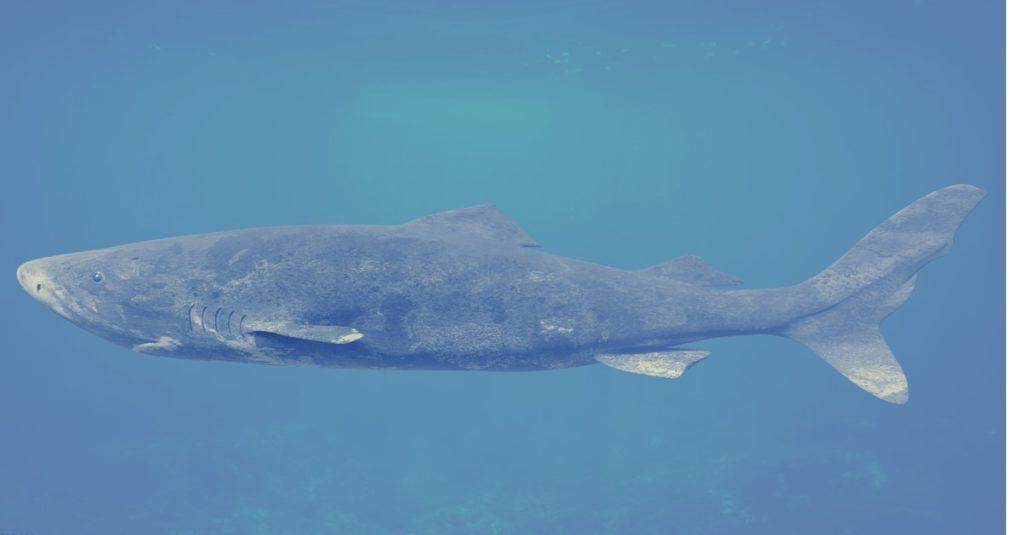
These sharks can survive in extremely cold temperatures and are the longest-living vertebrate animals.
©Dotted Yeti/Shutterstock.com
The Greenland shark is a unique species of shark and can be found in the cold waters of the North Atlantic Ocean. These sharks are some of the longest-living vertebrates on earth, often reaching hundreds of years old. Greenland sharks have a very unique appearance, resembling a submarine in shape. Their skin is thick and rough and is dark gray or brown. They grow to an average of 21 feet and weigh upwards of 2,200 pounds.
The Greenland shark has adapted to survive in near-freezing waters and is usually found at depths anywhere between 800 feet and 7,200 feet. These sharks are opportunistic feeders and usually scavenge for their food, collecting anything that sinks to their depths. Unfortunately, due to their long lifespans and slow growth rate, they are subject to overfishing and environmental changes.
Fun fact: The oldest known Greenland shark is at least 390 years old, but some scientists believe it could be as old as 510!
1. Basking Shark (Cetorhinus maximus) – up to 40 feet long

The most impressive feature of the basking shark is its mouth, which opens up to 3 feet wide.
©Martin Prochazkacz/Shutterstock.com
Coming in second place to the Whale shark as the world’s largest fish, the basking shark is a monster! This shark is the biggest fish found in Canadian water. They get their name from their tendency to swim near the surface of the water and bask in the sun. Basking sharks are slow-moving sharks that lack any teeth. Instead, they have a mouth full of tiny hook-like structures which allow them to filter feed. They have long bodies and enormous mouths and are grayish-brown in color.
Basking sharks prefer coastal waters and will often migrate, following the movements of plankton. They feed by swimming with their mouths wide open, catching most things in their way, including small fish, plankton, krill, and copepods. These sharks are a vulnerable species due to their declining populations. They have been overfished for their liver oil and fins and are now protected in many countries worldwide, including Canada.
Summary of 9 Biggest Fish Found in Canadian Waters
| Rank | Fish | Size |
|---|---|---|
| 1 | Basking Shark | Up to 40 feet |
| 2 | Greenland Shark | Up to 23 feet |
| 3 | Atlantic Bluefin Tuna | Up to 13 feet |
| 4 | Blue Shark | Up to 13 feet |
| 5 | White Sturgeon | around 10 feet |
| 6 | Lake Sturgeon | Over 7 feet |
| 7 | Muskellunge | Up to 5.6 feet |
| 8 | Chinook Salmon | Up to 5 feet |
| 9 | Northern Pike | Up to 4 feet |
The photo featured at the top of this post is © CSNafzger/Shutterstock.com
Thank you for reading! Have some feedback for us? Contact the AZ Animals editorial team.







